Export Labeled Data from Signal Labeler for Deep Learning Classification
This example shows how to label and export data using the Signal Labeler app, and then train and classify the labeled data with a deep learning network. The data set consists of 750 signals with 2000 samples each. The signals correspond to realizations of random noise processes belonging to three distributions: white, brown, and pink noise. The brown noise has two additional sinusoidal components at 0.19 radians/sample and 0.33 radians/sample frequencies and the pink noise has two additional sinusoidal components at 0.17 radians/sample and 0.31 radians/sample frequencies. The data set contains 250 signals for each class.
Label Data Set Using Signal Labeler App
Download and Prepare the Data
Download the data files into your temporary directory, whose location is specified by MATLAB®'s tempdir command.
dataURL = "https://ssd.mathworks.com/supportfiles/SPT/data/NoiseSignalsDataSet.zip"; datasetFolder = fullfile(tempdir,"NoiseSignalsDataSet"); zipFile = fullfile(tempdir,"NoiseSignalsDataSet.zip"); if ~exist(datasetFolder,"dir") websave(zipFile,dataURL); unzip(zipFile,datasetFolder); end
Import Signals from Files
Open the Signal Labeler app by typing the signalLabeler command. To import signals from multiple files in a folder, on the Labeler tab, click Import and select From Folders in the Members list. In the dialog box, browse to select the NoiseSignalsDataSet folder and click Import.
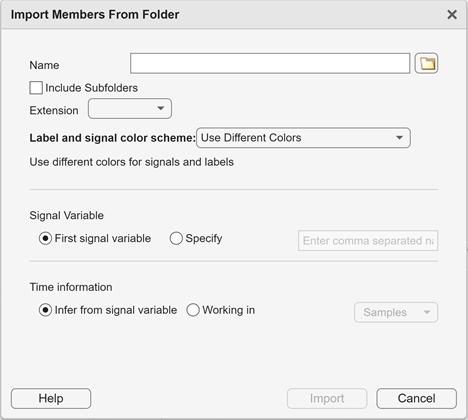
The imported files appear in the Labeled Signal Set Members browser.
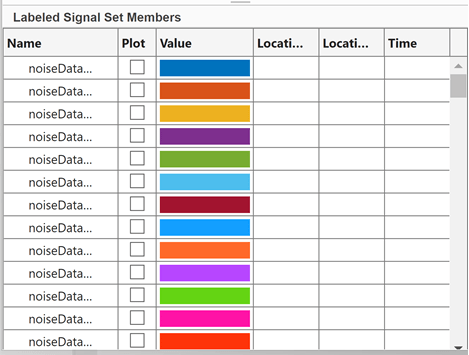
Create Label Definitions
To label data in the Signal Labeler app, first create a label definition. Since each member has one label, create an attribute label definition with categorical data type. To add a signal label definition to your labeled signal set, click Add Definition on the Labeler tab and select Add label definition. In the dialog box, specify these:
Label Name — Specify the name in the text box as
NoiseType.Label Type — Select
Attribute.Data Type — Select
categorical.Categories — Enter each category on a new line:
white,brown,pink.
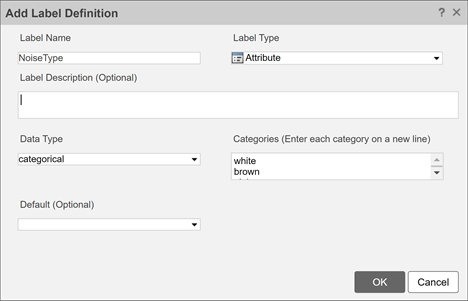
Manual Labeling
Plot one signal of each noise type by selecting the check boxes next to the file names in the Labeled Signal Set Members browser. Notice that it is hard to distinguish the signal types by looking at the time-domain plots. However, the distinctive features of each signal are evident by looking in the frequency-domain spectrum plots. To plot the spectral estimates of the signals, on the Display tab, click Spectrum to open a spectrum view.
The spectrum shows sinusoidal components at 0.19 radians/sample and 0.33 radians/sample frequency for a brown noise signal.

The spectrum shows sinusoidal components at 0.17 radians/sample and 0.31 radians/sample frequency for a pink noise signal.
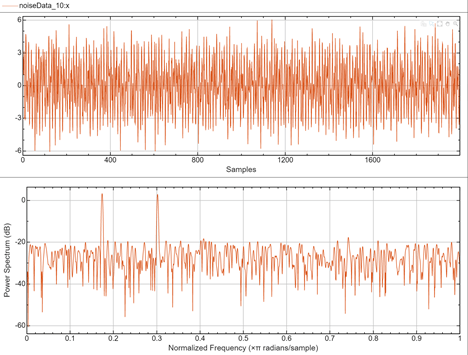
The spectrum shows no sinusoidal component for a white noise signal.
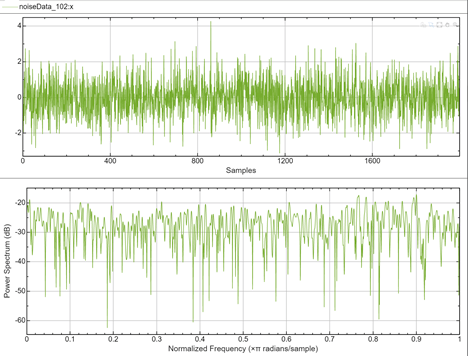
To label interactively, plot a signal and specify the label value, based on spectrum of the signal. In the Set Value section of the Labeler tab. Click the Label Attribute to apply the label value. Do this for the remaining signals in the set.

Export Labeled Data
After manually labeling all the noise signals, export the resulting labeled data set to the MATLAB Workspace. Click Export on the Labeler tab and select To Workspace under Labeled Signal Set. In the dialog box, specify the name lssAll and an optional brief description. The lssAll variable contains a labeledSignalSet object that groups together all the signals, label definitions, and label values that you created in the app.
For convenience, the resulting exported labeledSignalSet object is attached with this example so that you do not have to label all the signals manually and can move on to learning how to use the object to train an AI model.
Load the labeled signal set.
load("lssAll.mat")Set the AlternateFileSystemRoots to the folder location where the files were downloaded.
if lssAll.Source.Folders ~= datasetFolder lssAll.setAlternateFileSystemRoots([lssAll.Source.Folders,datasetFolder]); end
Training a Deep Learning Network
To train a deep learning classifier model, create a signal datastore and a label datastore from the exported labeled signal set. Combine the two datastores to train the network with pairs of signals and response labels.
Create a combined datastore from the exported labeled signal set using NoiseType labels.
[sdsAll,ldsAll] = lssAll.createDatastores("NoiseType");
cdsAll = combine(sdsAll,ldsAll);Split the data into two sets: A training set containing 80% of the signals and a testing set with the rest. Use the splitlabels function to ensure that the training and test partitions have the same proportion of labels from each noise type. For the test set the combined datastore is not used because signals and labels need to be used separately when testing the network's classification performance.
% specify UnderlyingDatastoreIndex as 2 so that splitlabels operates on the % datastore that contains the labels splitIndices = splitlabels(cdsAll,0.8,"randomized","UnderlyingDatastoreIndex",2); % Get the training set cdsTrain = subset(cdsAll,splitIndices{1}); % Get the test set sdsTest = subset(sdsAll,splitIndices{2}); ldsTest = subset(ldsAll,splitIndices{2});
Define a convolution neural network to classify the signal into the three noise classes. Specify the minimum sequence length in the SequenceInputLayer object as the signal length.
numClasses = 3;
layers = [
sequenceInputLayer(1,"MinLength",2e3)
convolution1dLayer(5,1,"Padding","same")
stftLayer("Window",hamming(256),"OverlapLength",192)
convolution2dLayer(5,20,"Name","","Padding","same")
reluLayer("Name", "relu1")
convolution2dLayer(3,20,"Padding",1,"Name","")
reluLayer("Name","relu2")
convolution2dLayer(3,20,"Padding",1,"Name","conv3")
reluLayer("Name","relu3")
globalAveragePooling2dLayer()
fullyConnectedLayer(numClasses,"Name","fc")
softmaxLayer("Name","softmax")];
Define training options. An Adam optimizer with 10 epochs and mini batch size of 32 is chosen.
options = trainingOptions("adam", ... InitialLearnRate = 1e-2, ... MaxEpochs=10, ... MiniBatchSize=32, ... Shuffle="every-epoch", ... Plots="none", ... ExecutionEnvironment="auto", ... Verbose=true);
Train the neural network with the combined datastore, layers, and training options. Specify a cross-entropy loss function.
trainedNet = trainnet(cdsTrain,layers,crossentropy=options);
Iteration Epoch TimeElapsed LearnRate TrainingLoss
_________ _____ ___________ _________ ____________
1 1 00:00:17 0.01 1.7303
50 3 00:01:09 0.01 0.63194
100 6 00:02:04 0.01 0.45514
150 9 00:02:52 0.01 0.4473
180 10 00:03:26 0.01 0.49408
Training stopped: Max epochs completed
Measure the performance of the trained network using the test data set. Use the minibatchpredict function to predict the labels for all signals in the test datastore sdsTest. Use the ground truth test labels in the ldsTest datastore to measure the classification performance.
probmatrix = minibatchpredict(trainedNet,sdsTest);
testlabelsCell = ldsTest.readall;
testLabelsArr = [testlabelsCell{:}];
ypred = scores2label(probmatrix,categories(testLabelsArr));
figure
cm = confusionchart(testLabelsArr,ypred, ...
ColumnSummary="column-normalized",RowSummary="row-normalized");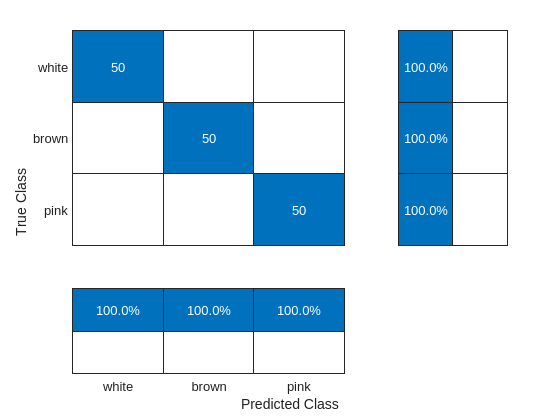
The network is able to classify each noise type with 100% accuracy.
Conclusion
This example showed how to label data in Signal Labeler app and use the exported data to train and test a deep learning classifier.
See Also
Functions
confusionchart(Deep Learning Toolbox) |minibatchpredict(Deep Learning Toolbox) |scores2label(Deep Learning Toolbox) |trainingOptions(Deep Learning Toolbox) |trainnet(Deep Learning Toolbox)